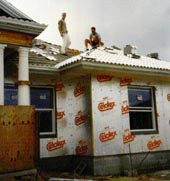
PVRES Gets a Cool Roof
 Over the last five years, FSEC has conducted numerous experiments examining
how altering residences to white roofs can reduce cooling energy needs.
The average cooling energy reduction based on tests
in a dozen homes converted to white roofs has averaged 19%. Based on
testing performed at the FSEC's Flexible
Roof Facility last summer, we learned that of the evaluated roofing systems
(radiant barriers, added ventilation, white tile and white metal roofs),
white tile provides the best cooling related performance of any of the options.
Relative to a black asphalt shingle roof, our white tile roof saw a 76% reduction
in overall summer ceiling heat flux (all test cells have R-19 ceiling insulation
present).
Over the last five years, FSEC has conducted numerous experiments examining
how altering residences to white roofs can reduce cooling energy needs.
The average cooling energy reduction based on tests
in a dozen homes converted to white roofs has averaged 19%. Based on
testing performed at the FSEC's Flexible
Roof Facility last summer, we learned that of the evaluated roofing systems
(radiant barriers, added ventilation, white tile and white metal roofs),
white tile provides the best cooling related performance of any of the options.
Relative to a black asphalt shingle roof, our white tile roof saw a 76% reduction
in overall summer ceiling heat flux (all test cells have R-19 ceiling insulation
present).
 Moreover, when the outside summer air temperatures were at
their peak, the coincident peak attic air temperature difference was
40oF lower in the white tile test cell (91.4oF) than the construction
with black asphalt shingles (131.5oF). The measured attic air temperature
is actually lower in the attic than the ambient air temperature until 2 PM
in the afternoon on a typical summer day!
Moreover, when the outside summer air temperatures were at
their peak, the coincident peak attic air temperature difference was
40oF lower in the white tile test cell (91.4oF) than the construction
with black asphalt shingles (131.5oF). The measured attic air temperature
is actually lower in the attic than the ambient air temperature until 2 PM
in the afternoon on a typical summer day!
The developing case for the superiority of white tile roofs
in Florida's climate is another illustration of the wisdom of considering
traditional architecture. It seems that after World War II, prior to air
conditioning, white tile roofs were nearly universal in new construction
in South Florida because of their perceived advantage in fighting the heat.
In a 1950 article appearing in House Beautiful entitled "Your House
in Florida", architect Wolfgang Langewiesche says it all:
"Your roof must be white. The white color throws
much of the heat back into the sky before it ever gets into the
roof. This is one climate control idea that is universally accepted
in Florida now...Insulation is a must, but without the white color,
would finally get hot."
 Both our test homes have R-30 insulation blown in the attic,
but two major differences for the PVRES home. The improved house features
a white Mission concrete "S" tile roof -- donated to the project
by the Monier Company --
to take advantage of its superior thermal performance. The control home's
roof is conventional: popular gray-brown asphalt shingles. We had both roof
materials evaluated by DSET
Laboratories. The solar reflectance of the Monier white S-tile tested
at 77% while the reflectance of the gray-brown architectural asphalt shingle
was only 7%. The tile roof was installed on the PVRES home in January of
1998.
Both our test homes have R-30 insulation blown in the attic,
but two major differences for the PVRES home. The improved house features
a white Mission concrete "S" tile roof -- donated to the project
by the Monier Company --
to take advantage of its superior thermal performance. The control home's
roof is conventional: popular gray-brown asphalt shingles. We had both roof
materials evaluated by DSET
Laboratories. The solar reflectance of the Monier white S-tile tested
at 77% while the reflectance of the gray-brown architectural asphalt shingle
was only 7%. The tile roof was installed on the PVRES home in January of
1998.
Secondly, the duct system in the PVRES home is located within
the conditioned space -- perhaps the biggest design challenge of the entire
project. In the control home the ducts are located in the attic, the current
practice in almost all Florida homes being constructed.

![]()



